TensorFlow(十七):训练自己的图片分类模型
(一)下载inception-v3--见TensorFlow(十四)
(二)准备训练用的图片集,因为我没有图片集,所以写了个自动抓取百度图片的脚本-见抓取百度图片
(三)创建retrain.py文件,进行重训练。(因为之前遇到不同版本上的不同,遇到过坑,上源码)
# -*- coding: utf-8 -*-
# @Author : Felix Wang
# @time : 2018/6/27 11:46 # Copyright 2015 The TensorFlow Authors. All Rights Reserved.
#
# Licensed under the Apache License, Version 2.0 (the "License");
# you may not use this file except in compliance with the License.
# You may obtain a copy of the License at
#
# http://www.apache.org/licenses/LICENSE-2.0
#
# Unless required by applicable law or agreed to in writing, software
# distributed under the License is distributed on an "AS IS" BASIS,
# WITHOUT WARRANTIES OR CONDITIONS OF ANY KIND, either express or implied.
# See the License for the specific language governing permissions and
# limitations under the License.
# ==============================================================================
r"""Simple transfer learning with Inception v3 or Mobilenet models. With support for TensorBoard. This example shows how to take a Inception v3 or Mobilenet model trained on
ImageNet images, and train a new top layer that can recognize other classes of
images. The top layer receives as input a 2048-dimensional vector (1001-dimensional for
Mobilenet) for each image. We train a softmax layer on top of this
representation. Assuming the softmax layer contains N labels, this corresponds
to learning N + 2048*N (or 1001*N) model parameters corresponding to the
learned biases and weights. Here's an example, which assumes you have a folder containing class-named
subfolders, each full of images for each label. The example folder flower_photos
should have a structure like this: ~/flower_photos/daisy/photo1.jpg
~/flower_photos/daisy/photo2.jpg
...
~/flower_photos/rose/anotherphoto77.jpg
...
~/flower_photos/sunflower/somepicture.jpg The subfolder names are important, since they define what label is applied to
each image, but the filenames themselves don't matter. Once your images are
prepared, you can run the training with a command like this: bash:
bazel build tensorflow/examples/image_retraining:retrain && \
bazel-bin/tensorflow/examples/image_retraining/retrain \
--image_dir ~/flower_photos Or, if you have a pip installation of tensorflow, `retrain.py` can be run
without bazel: bash:
python tensorflow/examples/image_retraining/retrain.py \
--image_dir ~/flower_photos You can replace the image_dir argument with any folder containing subfolders of
images. The label for each image is taken from the name of the subfolder it's
in. This produces a new model file that can be loaded and run by any TensorFlow
program, for example the label_image sample code. By default this script will use the high accuracy, but comparatively large and
slow Inception v3 model architecture. It's recommended that you start with this
to validate that you have gathered good training data, but if you want to deploy
on resource-limited platforms, you can try the `--architecture` flag with a
Mobilenet model. For example: bash:
python tensorflow/examples/image_retraining/retrain.py \
--image_dir ~/flower_photos --architecture mobilenet_1.0_224 There are 32 different Mobilenet models to choose from, with a variety of file
size and latency options. The first number can be '1.0', '0.75', '0.50', or
'0.25' to control the size, and the second controls the input image size, either
'224', '192', '160', or '128', with smaller sizes running faster. See
https://research.googleblog.com/2017/06/mobilenets-open-source-models-for.html
for more information on Mobilenet. To use with TensorBoard: By default, this script will log summaries to /tmp/retrain_logs directory Visualize the summaries with this command: tensorboard --logdir /tmp/retrain_logs """
from __future__ import absolute_import
from __future__ import division
from __future__ import print_function import argparse
from datetime import datetime
import hashlib
import os.path
import random
import re
import sys
import tarfile import numpy as np
from six.moves import urllib
import tensorflow as tf from tensorflow.python.framework import graph_util
from tensorflow.python.framework import tensor_shape
from tensorflow.python.platform import gfile
from tensorflow.python.util import compat FLAGS = None # These are all parameters that are tied to the particular model architecture
# we're using for Inception v3. These include things like tensor names and their
# sizes. If you want to adapt this script to work with another model, you will
# need to update these to reflect the values in the network you're using.
MAX_NUM_IMAGES_PER_CLASS = 2 ** 27 - 1 # ~134M def create_image_lists(image_dir, testing_percentage, validation_percentage):
"""Builds a list of training images from the file system. Analyzes the sub folders in the image directory, splits them into stable
training, testing, and validation sets, and returns a data structure
describing the lists of images for each label and their paths. Args:
image_dir: String path to a folder containing subfolders of images.
testing_percentage: Integer percentage of the images to reserve for tests.
validation_percentage: Integer percentage of images reserved for validation. Returns:
A dictionary containing an entry for each label subfolder, with images split
into training, testing, and validation sets within each label.
"""
if not gfile.Exists(image_dir):
tf.logging.error("Image directory '" + image_dir + "' not found.")
return None
result = {}
sub_dirs = [x[0] for x in gfile.Walk(image_dir)]
# The root directory comes first, so skip it.
is_root_dir = True
for sub_dir in sub_dirs:
if is_root_dir:
is_root_dir = False
continue
extensions = ['jpg', 'jpeg', 'JPG', 'JPEG']
file_list = []
dir_name = os.path.basename(sub_dir)
if dir_name == image_dir:
continue
tf.logging.info("Looking for images in '" + dir_name + "'")
for extension in extensions:
file_glob = os.path.join(image_dir, dir_name, '*.' + extension)
file_list.extend(gfile.Glob(file_glob))
if not file_list:
tf.logging.warning('No files found')
continue
if len(file_list) < 20:
tf.logging.warning(
'WARNING: Folder has less than 20 images, which may cause issues.')
elif len(file_list) > MAX_NUM_IMAGES_PER_CLASS:
tf.logging.warning(
'WARNING: Folder {} has more than {} images. Some images will '
'never be selected.'.format(dir_name, MAX_NUM_IMAGES_PER_CLASS))
label_name = re.sub(r'[^a-z0-9]+', ' ', dir_name.lower())
training_images = []
testing_images = []
validation_images = []
for file_name in file_list:
base_name = os.path.basename(file_name)
# We want to ignore anything after '_nohash_' in the file name when
# deciding which set to put an image in, the data set creator has a way of
# grouping photos that are close variations of each other. For example
# this is used in the plant disease data set to group multiple pictures of
# the same leaf.
hash_name = re.sub(r'_nohash_.*$', '', file_name)
# This looks a bit magical, but we need to decide whether this file should
# go into the training, testing, or validation sets, and we want to keep
# existing files in the same set even if more files are subsequently
# added.
# To do that, we need a stable way of deciding based on just the file name
# itself, so we do a hash of that and then use that to generate a
# probability value that we use to assign it.
hash_name_hashed = hashlib.sha1(compat.as_bytes(hash_name)).hexdigest()
percentage_hash = ((int(hash_name_hashed, 16) %
(MAX_NUM_IMAGES_PER_CLASS + 1)) *
(100.0 / MAX_NUM_IMAGES_PER_CLASS))
if percentage_hash < validation_percentage:
validation_images.append(base_name)
elif percentage_hash < (testing_percentage + validation_percentage):
testing_images.append(base_name)
else:
training_images.append(base_name)
result[label_name] = {
'dir': dir_name,
'training': training_images,
'testing': testing_images,
'validation': validation_images,
}
return result def get_image_path(image_lists, label_name, index, image_dir, category):
""""Returns a path to an image for a label at the given index. Args:
image_lists: Dictionary of training images for each label.
label_name: Label string we want to get an image for.
index: Int offset of the image we want. This will be moduloed by the
available number of images for the label, so it can be arbitrarily large.
image_dir: Root folder string of the subfolders containing the training
images.
category: Name string of set to pull images from - training, testing, or
validation. Returns:
File system path string to an image that meets the requested parameters. """
if label_name not in image_lists:
tf.logging.fatal('Label does not exist %s.', label_name)
label_lists = image_lists[label_name]
if category not in label_lists:
tf.logging.fatal('Category does not exist %s.', category)
category_list = label_lists[category]
if not category_list:
tf.logging.fatal('Label %s has no images in the category %s.',
label_name, category)
mod_index = index % len(category_list)
base_name = category_list[mod_index]
sub_dir = label_lists['dir']
full_path = os.path.join(image_dir, sub_dir, base_name)
return full_path def get_bottleneck_path(image_lists, label_name, index, bottleneck_dir,
category, architecture):
""""Returns a path to a bottleneck file for a label at the given index. Args:
image_lists: Dictionary of training images for each label.
label_name: Label string we want to get an image for.
index: Integer offset of the image we want. This will be moduloed by the
available number of images for the label, so it can be arbitrarily large.
bottleneck_dir: Folder string holding cached files of bottleneck values.
category: Name string of set to pull images from - training, testing, or
validation.
architecture: The name of the model architecture. Returns:
File system path string to an image that meets the requested parameters.
"""
return get_image_path(image_lists, label_name, index, bottleneck_dir,
category) + '_' + architecture + '.txt' def create_model_graph(model_info):
""""Creates a graph from saved GraphDef file and returns a Graph object. Args:
model_info: Dictionary containing information about the model architecture. Returns:
Graph holding the trained Inception network, and various tensors we'll be
manipulating.
"""
with tf.Graph().as_default() as graph:
model_path = os.path.join(FLAGS.model_dir, model_info['model_file_name'])
with gfile.FastGFile(model_path, 'rb') as f:
graph_def = tf.GraphDef()
graph_def.ParseFromString(f.read())
bottleneck_tensor, resized_input_tensor = (tf.import_graph_def(
graph_def,
name='',
return_elements=[
model_info['bottleneck_tensor_name'],
model_info['resized_input_tensor_name'],
]))
return graph, bottleneck_tensor, resized_input_tensor def run_bottleneck_on_image(sess, image_data, image_data_tensor,
decoded_image_tensor, resized_input_tensor,
bottleneck_tensor):
"""Runs inference on an image to extract the 'bottleneck' summary layer. Args:
sess: Current active TensorFlow Session.
image_data: String of raw JPEG data.
image_data_tensor: Input data layer in the graph.
decoded_image_tensor: Output of initial image resizing and preprocessing.
resized_input_tensor: The input node of the recognition graph.
bottleneck_tensor: Layer before the final softmax. Returns:
Numpy array of bottleneck values.
"""
# First decode the JPEG image, resize it, and rescale the pixel values.
resized_input_values = sess.run(decoded_image_tensor,
{image_data_tensor: image_data})
# Then run it through the recognition network.
bottleneck_values = sess.run(bottleneck_tensor,
{resized_input_tensor: resized_input_values})
bottleneck_values = np.squeeze(bottleneck_values)
return bottleneck_values def maybe_download_and_extract(data_url):
"""Download and extract model tar file. If the pretrained model we're using doesn't already exist, this function
downloads it from the TensorFlow.org website and unpacks it into a directory. Args:
data_url: Web location of the tar file containing the pretrained model.
"""
dest_directory = FLAGS.model_dir
if not os.path.exists(dest_directory):
os.makedirs(dest_directory)
filename = data_url.split('/')[-1]
filepath = os.path.join(dest_directory, filename)
if not os.path.exists(filepath): def _progress(count, block_size, total_size):
sys.stdout.write('\r>> Downloading %s %.1f%%' %
(filename,
float(count * block_size) / float(total_size) * 100.0))
sys.stdout.flush() filepath, _ = urllib.request.urlretrieve(data_url, filepath, _progress)
print()
statinfo = os.stat(filepath)
tf.logging.info('Successfully downloaded', filename, statinfo.st_size,
'bytes.')
tarfile.open(filepath, 'r:gz').extractall(dest_directory) def ensure_dir_exists(dir_name):
"""Makes sure the folder exists on disk. Args:
dir_name: Path string to the folder we want to create.
"""
if not os.path.exists(dir_name):
os.makedirs(dir_name) bottleneck_path_2_bottleneck_values = {} def create_bottleneck_file(bottleneck_path, image_lists, label_name, index,
image_dir, category, sess, jpeg_data_tensor,
decoded_image_tensor, resized_input_tensor,
bottleneck_tensor):
"""Create a single bottleneck file."""
tf.logging.info('Creating bottleneck at ' + bottleneck_path)
image_path = get_image_path(image_lists, label_name, index,
image_dir, category)
if not gfile.Exists(image_path):
tf.logging.fatal('File does not exist %s', image_path)
image_data = gfile.FastGFile(image_path, 'rb').read()
try:
bottleneck_values = run_bottleneck_on_image(
sess, image_data, jpeg_data_tensor, decoded_image_tensor,
resized_input_tensor, bottleneck_tensor)
except Exception as e:
raise RuntimeError('Error during processing file %s (%s)' % (image_path,
str(e)))
bottleneck_string = ','.join(str(x) for x in bottleneck_values)
with open(bottleneck_path, 'w') as bottleneck_file:
bottleneck_file.write(bottleneck_string) def get_or_create_bottleneck(sess, image_lists, label_name, index, image_dir,
category, bottleneck_dir, jpeg_data_tensor,
decoded_image_tensor, resized_input_tensor,
bottleneck_tensor, architecture):
"""Retrieves or calculates bottleneck values for an image. If a cached version of the bottleneck data exists on-disk, return that,
otherwise calculate the data and save it to disk for future use. Args:
sess: The current active TensorFlow Session.
image_lists: Dictionary of training images for each label.
label_name: Label string we want to get an image for.
index: Integer offset of the image we want. This will be modulo-ed by the
available number of images for the label, so it can be arbitrarily large.
image_dir: Root folder string of the subfolders containing the training
images.
category: Name string of which set to pull images from - training, testing,
or validation.
bottleneck_dir: Folder string holding cached files of bottleneck values.
jpeg_data_tensor: The tensor to feed loaded jpeg data into.
decoded_image_tensor: The output of decoding and resizing the image.
resized_input_tensor: The input node of the recognition graph.
bottleneck_tensor: The output tensor for the bottleneck values.
architecture: The name of the model architecture. Returns:
Numpy array of values produced by the bottleneck layer for the image.
"""
label_lists = image_lists[label_name]
sub_dir = label_lists['dir']
sub_dir_path = os.path.join(bottleneck_dir, sub_dir)
ensure_dir_exists(sub_dir_path)
bottleneck_path = get_bottleneck_path(image_lists, label_name, index,
bottleneck_dir, category, architecture)
if not os.path.exists(bottleneck_path):
create_bottleneck_file(bottleneck_path, image_lists, label_name, index,
image_dir, category, sess, jpeg_data_tensor,
decoded_image_tensor, resized_input_tensor,
bottleneck_tensor)
with open(bottleneck_path, 'r') as bottleneck_file:
bottleneck_string = bottleneck_file.read()
did_hit_error = False
try:
bottleneck_values = [float(x) for x in bottleneck_string.split(',')]
except ValueError:
tf.logging.warning('Invalid float found, recreating bottleneck')
did_hit_error = True
if did_hit_error:
create_bottleneck_file(bottleneck_path, image_lists, label_name, index,
image_dir, category, sess, jpeg_data_tensor,
decoded_image_tensor, resized_input_tensor,
bottleneck_tensor)
with open(bottleneck_path, 'r') as bottleneck_file:
bottleneck_string = bottleneck_file.read()
# Allow exceptions to propagate here, since they shouldn't happen after a
# fresh creation
bottleneck_values = [float(x) for x in bottleneck_string.split(',')]
return bottleneck_values def cache_bottlenecks(sess, image_lists, image_dir, bottleneck_dir,
jpeg_data_tensor, decoded_image_tensor,
resized_input_tensor, bottleneck_tensor, architecture):
"""Ensures all the training, testing, and validation bottlenecks are cached. Because we're likely to read the same image multiple times (if there are no
distortions applied during training) it can speed things up a lot if we
calculate the bottleneck layer values once for each image during
preprocessing, and then just read those cached values repeatedly during
training. Here we go through all the images we've found, calculate those
values, and save them off. Args:
sess: The current active TensorFlow Session.
image_lists: Dictionary of training images for each label.
image_dir: Root folder string of the subfolders containing the training
images.
bottleneck_dir: Folder string holding cached files of bottleneck values.
jpeg_data_tensor: Input tensor for jpeg data from file.
decoded_image_tensor: The output of decoding and resizing the image.
resized_input_tensor: The input node of the recognition graph.
bottleneck_tensor: The penultimate output layer of the graph.
architecture: The name of the model architecture. Returns:
Nothing.
"""
how_many_bottlenecks = 0
ensure_dir_exists(bottleneck_dir)
for label_name, label_lists in image_lists.items():
for category in ['training', 'testing', 'validation']:
category_list = label_lists[category]
for index, unused_base_name in enumerate(category_list):
get_or_create_bottleneck(
sess, image_lists, label_name, index, image_dir, category,
bottleneck_dir, jpeg_data_tensor, decoded_image_tensor,
resized_input_tensor, bottleneck_tensor, architecture) how_many_bottlenecks += 1
if how_many_bottlenecks % 100 == 0:
tf.logging.info(
str(how_many_bottlenecks) + ' bottleneck files created.') def get_random_cached_bottlenecks(sess, image_lists, how_many, category,
bottleneck_dir, image_dir, jpeg_data_tensor,
decoded_image_tensor, resized_input_tensor,
bottleneck_tensor, architecture):
"""Retrieves bottleneck values for cached images. If no distortions are being applied, this function can retrieve the cached
bottleneck values directly from disk for images. It picks a random set of
images from the specified category. Args:
sess: Current TensorFlow Session.
image_lists: Dictionary of training images for each label.
how_many: If positive, a random sample of this size will be chosen.
If negative, all bottlenecks will be retrieved.
category: Name string of which set to pull from - training, testing, or
validation.
bottleneck_dir: Folder string holding cached files of bottleneck values.
image_dir: Root folder string of the subfolders containing the training
images.
jpeg_data_tensor: The layer to feed jpeg image data into.
decoded_image_tensor: The output of decoding and resizing the image.
resized_input_tensor: The input node of the recognition graph.
bottleneck_tensor: The bottleneck output layer of the CNN graph.
architecture: The name of the model architecture. Returns:
List of bottleneck arrays, their corresponding ground truths, and the
relevant filenames.
"""
class_count = len(image_lists.keys())
bottlenecks = []
ground_truths = []
filenames = []
if how_many >= 0:
# Retrieve a random sample of bottlenecks.
for unused_i in range(how_many):
label_index = random.randrange(class_count)
label_name = list(image_lists.keys())[label_index]
image_index = random.randrange(MAX_NUM_IMAGES_PER_CLASS + 1)
image_name = get_image_path(image_lists, label_name, image_index,
image_dir, category)
bottleneck = get_or_create_bottleneck(
sess, image_lists, label_name, image_index, image_dir, category,
bottleneck_dir, jpeg_data_tensor, decoded_image_tensor,
resized_input_tensor, bottleneck_tensor, architecture)
ground_truth = np.zeros(class_count, dtype=np.float32)
ground_truth[label_index] = 1.0
bottlenecks.append(bottleneck)
ground_truths.append(ground_truth)
filenames.append(image_name)
else:
# Retrieve all bottlenecks.
for label_index, label_name in enumerate(image_lists.keys()):
for image_index, image_name in enumerate(
image_lists[label_name][category]):
image_name = get_image_path(image_lists, label_name, image_index,
image_dir, category)
bottleneck = get_or_create_bottleneck(
sess, image_lists, label_name, image_index, image_dir, category,
bottleneck_dir, jpeg_data_tensor, decoded_image_tensor,
resized_input_tensor, bottleneck_tensor, architecture)
ground_truth = np.zeros(class_count, dtype=np.float32)
ground_truth[label_index] = 1.0
bottlenecks.append(bottleneck)
ground_truths.append(ground_truth)
filenames.append(image_name)
return bottlenecks, ground_truths, filenames def get_random_distorted_bottlenecks(
sess, image_lists, how_many, category, image_dir, input_jpeg_tensor,
distorted_image, resized_input_tensor, bottleneck_tensor):
"""Retrieves bottleneck values for training images, after distortions. If we're training with distortions like crops, scales, or flips, we have to
recalculate the full model for every image, and so we can't use cached
bottleneck values. Instead we find random images for the requested category,
run them through the distortion graph, and then the full graph to get the
bottleneck results for each. Args:
sess: Current TensorFlow Session.
image_lists: Dictionary of training images for each label.
how_many: The integer number of bottleneck values to return.
category: Name string of which set of images to fetch - training, testing,
or validation.
image_dir: Root folder string of the subfolders containing the training
images.
input_jpeg_tensor: The input layer we feed the image data to.
distorted_image: The output node of the distortion graph.
resized_input_tensor: The input node of the recognition graph.
bottleneck_tensor: The bottleneck output layer of the CNN graph. Returns:
List of bottleneck arrays and their corresponding ground truths.
"""
class_count = len(image_lists.keys())
bottlenecks = []
ground_truths = []
for unused_i in range(how_many):
label_index = random.randrange(class_count)
label_name = list(image_lists.keys())[label_index]
image_index = random.randrange(MAX_NUM_IMAGES_PER_CLASS + 1)
image_path = get_image_path(image_lists, label_name, image_index, image_dir,
category)
if not gfile.Exists(image_path):
tf.logging.fatal('File does not exist %s', image_path)
jpeg_data = gfile.FastGFile(image_path, 'rb').read()
# Note that we materialize the distorted_image_data as a numpy array before
# sending running inference on the image. This involves 2 memory copies and
# might be optimized in other implementations.
distorted_image_data = sess.run(distorted_image,
{input_jpeg_tensor: jpeg_data})
bottleneck_values = sess.run(bottleneck_tensor,
{resized_input_tensor: distorted_image_data})
bottleneck_values = np.squeeze(bottleneck_values)
ground_truth = np.zeros(class_count, dtype=np.float32)
ground_truth[label_index] = 1.0
bottlenecks.append(bottleneck_values)
ground_truths.append(ground_truth)
return bottlenecks, ground_truths def should_distort_images(flip_left_right, random_crop, random_scale,
random_brightness):
"""Whether any distortions are enabled, from the input flags. Args:
flip_left_right: Boolean whether to randomly mirror images horizontally.
random_crop: Integer percentage setting the total margin used around the
crop box.
random_scale: Integer percentage of how much to vary the scale by.
random_brightness: Integer range to randomly multiply the pixel values by. Returns:
Boolean value indicating whether any distortions should be applied.
"""
return (flip_left_right or (random_crop != 0) or (random_scale != 0) or
(random_brightness != 0)) def add_input_distortions(flip_left_right, random_crop, random_scale,
random_brightness, input_width, input_height,
input_depth, input_mean, input_std):
"""Creates the operations to apply the specified distortions. During training it can help to improve the results if we run the images
through simple distortions like crops, scales, and flips. These reflect the
kind of variations we expect in the real world, and so can help train the
model to cope with natural data more effectively. Here we take the supplied
parameters and construct a network of operations to apply them to an image. Cropping
~~~~~~~~ Cropping is done by placing a bounding box at a random position in the full
image. The cropping parameter controls the size of that box relative to the
input image. If it's zero, then the box is the same size as the input and no
cropping is performed. If the value is 50%, then the crop box will be half the
width and height of the input. In a diagram it looks like this: < width >
+---------------------+
| |
| width - crop% |
| < > |
| +------+ |
| | | |
| | | |
| | | |
| +------+ |
| |
| |
+---------------------+ Scaling
~~~~~~~ Scaling is a lot like cropping, except that the bounding box is always
centered and its size varies randomly within the given range. For example if
the scale percentage is zero, then the bounding box is the same size as the
input and no scaling is applied. If it's 50%, then the bounding box will be in
a random range between half the width and height and full size. Args:
flip_left_right: Boolean whether to randomly mirror images horizontally.
random_crop: Integer percentage setting the total margin used around the
crop box.
random_scale: Integer percentage of how much to vary the scale by.
random_brightness: Integer range to randomly multiply the pixel values by.
graph.
input_width: Horizontal size of expected input image to model.
input_height: Vertical size of expected input image to model.
input_depth: How many channels the expected input image should have.
input_mean: Pixel value that should be zero in the image for the graph.
input_std: How much to divide the pixel values by before recognition. Returns:
The jpeg input layer and the distorted result tensor.
""" jpeg_data = tf.placeholder(tf.string, name='DistortJPGInput')
decoded_image = tf.image.decode_jpeg(jpeg_data, channels=input_depth)
decoded_image_as_float = tf.cast(decoded_image, dtype=tf.float32)
decoded_image_4d = tf.expand_dims(decoded_image_as_float, 0)
margin_scale = 1.0 + (random_crop / 100.0)
resize_scale = 1.0 + (random_scale / 100.0)
margin_scale_value = tf.constant(margin_scale)
resize_scale_value = tf.random_uniform(tensor_shape.scalar(),
minval=1.0,
maxval=resize_scale)
scale_value = tf.multiply(margin_scale_value, resize_scale_value)
precrop_width = tf.multiply(scale_value, input_width)
precrop_height = tf.multiply(scale_value, input_height)
precrop_shape = tf.stack([precrop_height, precrop_width])
precrop_shape_as_int = tf.cast(precrop_shape, dtype=tf.int32)
precropped_image = tf.image.resize_bilinear(decoded_image_4d,
precrop_shape_as_int)
precropped_image_3d = tf.squeeze(precropped_image, squeeze_dims=[0])
cropped_image = tf.random_crop(precropped_image_3d,
[input_height, input_width, input_depth])
if flip_left_right:
flipped_image = tf.image.random_flip_left_right(cropped_image)
else:
flipped_image = cropped_image
brightness_min = 1.0 - (random_brightness / 100.0)
brightness_max = 1.0 + (random_brightness / 100.0)
brightness_value = tf.random_uniform(tensor_shape.scalar(),
minval=brightness_min,
maxval=brightness_max)
brightened_image = tf.multiply(flipped_image, brightness_value)
offset_image = tf.subtract(brightened_image, input_mean)
mul_image = tf.multiply(offset_image, 1.0 / input_std)
distort_result = tf.expand_dims(mul_image, 0, name='DistortResult')
return jpeg_data, distort_result def variable_summaries(var):
"""Attach a lot of summaries to a Tensor (for TensorBoard visualization)."""
with tf.name_scope('summaries'):
mean = tf.reduce_mean(var)
tf.summary.scalar('mean', mean)
with tf.name_scope('stddev'):
stddev = tf.sqrt(tf.reduce_mean(tf.square(var - mean)))
tf.summary.scalar('stddev', stddev)
tf.summary.scalar('max', tf.reduce_max(var))
tf.summary.scalar('min', tf.reduce_min(var))
tf.summary.histogram('histogram', var) def add_final_training_ops(class_count, final_tensor_name, bottleneck_tensor,
bottleneck_tensor_size):
"""Adds a new softmax and fully-connected layer for training. We need to retrain the top layer to identify our new classes, so this function
adds the right operations to the graph, along with some variables to hold the
weights, and then sets up all the gradients for the backward pass. The set up for the softmax and fully-connected layers is based on:
https://www.tensorflow.org/versions/master/tutorials/mnist/beginners/index.html Args:
class_count: Integer of how many categories of things we're trying to
recognize.
final_tensor_name: Name string for the new final node that produces results.
bottleneck_tensor: The output of the main CNN graph.
bottleneck_tensor_size: How many entries in the bottleneck vector. Returns:
The tensors for the training and cross entropy results, and tensors for the
bottleneck input and ground truth input.
"""
with tf.name_scope('input'):
bottleneck_input = tf.placeholder_with_default(
bottleneck_tensor,
shape=[None, bottleneck_tensor_size],
name='BottleneckInputPlaceholder') ground_truth_input = tf.placeholder(tf.float32,
[None, class_count],
name='GroundTruthInput') # Organizing the following ops as `final_training_ops` so they're easier
# to see in TensorBoard
layer_name = 'final_training_ops'
with tf.name_scope(layer_name):
with tf.name_scope('weights'):
initial_value = tf.truncated_normal(
[bottleneck_tensor_size, class_count], stddev=0.001) layer_weights = tf.Variable(initial_value, name='final_weights') variable_summaries(layer_weights)
with tf.name_scope('biases'):
layer_biases = tf.Variable(tf.zeros([class_count]), name='final_biases')
variable_summaries(layer_biases)
with tf.name_scope('Wx_plus_b'):
logits = tf.matmul(bottleneck_input, layer_weights) + layer_biases
tf.summary.histogram('pre_activations', logits) final_tensor = tf.nn.softmax(logits, name=final_tensor_name)
tf.summary.histogram('activations', final_tensor) with tf.name_scope('cross_entropy'):
cross_entropy = tf.nn.softmax_cross_entropy_with_logits(
labels=ground_truth_input, logits=logits)
with tf.name_scope('total'):
cross_entropy_mean = tf.reduce_mean(cross_entropy)
tf.summary.scalar('cross_entropy', cross_entropy_mean) with tf.name_scope('train'):
optimizer = tf.train.GradientDescentOptimizer(FLAGS.learning_rate)
train_step = optimizer.minimize(cross_entropy_mean) return (train_step, cross_entropy_mean, bottleneck_input, ground_truth_input,
final_tensor) def add_evaluation_step(result_tensor, ground_truth_tensor):
"""Inserts the operations we need to evaluate the accuracy of our results. Args:
result_tensor: The new final node that produces results.
ground_truth_tensor: The node we feed ground truth data
into. Returns:
Tuple of (evaluation step, prediction).
"""
with tf.name_scope('accuracy'):
with tf.name_scope('correct_prediction'):
prediction = tf.argmax(result_tensor, 1)
correct_prediction = tf.equal(
prediction, tf.argmax(ground_truth_tensor, 1))
with tf.name_scope('accuracy'):
evaluation_step = tf.reduce_mean(tf.cast(correct_prediction, tf.float32))
tf.summary.scalar('accuracy', evaluation_step)
return evaluation_step, prediction def save_graph_to_file(sess, graph, graph_file_name):
output_graph_def = graph_util.convert_variables_to_constants(
sess, graph.as_graph_def(), [FLAGS.final_tensor_name])
with gfile.FastGFile(graph_file_name, 'wb') as f:
f.write(output_graph_def.SerializeToString())
return def prepare_file_system():
# Setup the directory we'll write summaries to for TensorBoard
if tf.gfile.Exists(FLAGS.summaries_dir):
tf.gfile.DeleteRecursively(FLAGS.summaries_dir)
tf.gfile.MakeDirs(FLAGS.summaries_dir)
if FLAGS.intermediate_store_frequency > 0:
ensure_dir_exists(FLAGS.intermediate_output_graphs_dir)
return def create_model_info(architecture):
"""Given the name of a model architecture, returns information about it. There are different base image recognition pretrained models that can be
retrained using transfer learning, and this function translates from the name
of a model to the attributes that are needed to download and train with it. Args:
architecture: Name of a model architecture. Returns:
Dictionary of information about the model, or None if the name isn't
recognized Raises:
ValueError: If architecture name is unknown.
"""
architecture = architecture.lower()
if architecture == 'inception_v3':
# pylint: disable=line-too-long
data_url = 'http://download.tensorflow.org/models/image/imagenet/inception-2015-12-05.tgz'
# pylint: enable=line-too-long
bottleneck_tensor_name = 'pool_3/_reshape:0'
bottleneck_tensor_size = 2048
input_width = 299
input_height = 299
input_depth = 3
resized_input_tensor_name = 'Mul:0'
model_file_name = 'classify_image_graph_def.pb'
input_mean = 128
input_std = 128
elif architecture.startswith('mobilenet_'):
parts = architecture.split('_')
if len(parts) != 3 and len(parts) != 4:
tf.logging.error("Couldn't understand architecture name '%s'",
architecture)
return None
version_string = parts[1]
if (version_string != '1.0' and version_string != '0.75' and
version_string != '0.50' and version_string != '0.25'):
tf.logging.error(
""""The Mobilenet version should be '1.0', '0.75', '0.50', or '0.25',
but found '%s' for architecture '%s'""",
version_string, architecture)
return None
size_string = parts[2]
if (size_string != '' and size_string != '' and
size_string != '' and size_string != ''):
tf.logging.error(
"""The Mobilenet input size should be '224', '192', '160', or '128',
but found '%s' for architecture '%s'""",
size_string, architecture)
return None
if len(parts) == 3:
is_quantized = False
else:
if parts[3] != 'quantized':
tf.logging.error(
"Couldn't understand architecture suffix '%s' for '%s'", parts[3],
architecture)
return None
is_quantized = True
data_url = 'http://download.tensorflow.org/models/mobilenet_v1_'
data_url += version_string + '_' + size_string + '_frozen.tgz'
bottleneck_tensor_name = 'MobilenetV1/Predictions/Reshape:0'
bottleneck_tensor_size = 1001
input_width = int(size_string)
input_height = int(size_string)
input_depth = 3
resized_input_tensor_name = 'input:0'
if is_quantized:
model_base_name = 'quantized_graph.pb'
else:
model_base_name = 'frozen_graph.pb'
model_dir_name = 'mobilenet_v1_' + version_string + '_' + size_string
model_file_name = os.path.join(model_dir_name, model_base_name)
input_mean = 127.5
input_std = 127.5
else:
tf.logging.error("Couldn't understand architecture name '%s'", architecture)
raise ValueError('Unknown architecture', architecture) return {
'data_url': data_url,
'bottleneck_tensor_name': bottleneck_tensor_name,
'bottleneck_tensor_size': bottleneck_tensor_size,
'input_width': input_width,
'input_height': input_height,
'input_depth': input_depth,
'resized_input_tensor_name': resized_input_tensor_name,
'model_file_name': model_file_name,
'input_mean': input_mean,
'input_std': input_std,
} def add_jpeg_decoding(input_width, input_height, input_depth, input_mean,
input_std):
"""Adds operations that perform JPEG decoding and resizing to the graph.. Args:
input_width: Desired width of the image fed into the recognizer graph.
input_height: Desired width of the image fed into the recognizer graph.
input_depth: Desired channels of the image fed into the recognizer graph.
input_mean: Pixel value that should be zero in the image for the graph.
input_std: How much to divide the pixel values by before recognition. Returns:
Tensors for the node to feed JPEG data into, and the output of the
preprocessing steps.
"""
jpeg_data = tf.placeholder(tf.string, name='DecodeJPGInput')
decoded_image = tf.image.decode_jpeg(jpeg_data, channels=input_depth)
decoded_image_as_float = tf.cast(decoded_image, dtype=tf.float32)
decoded_image_4d = tf.expand_dims(decoded_image_as_float, 0)
resize_shape = tf.stack([input_height, input_width])
resize_shape_as_int = tf.cast(resize_shape, dtype=tf.int32)
resized_image = tf.image.resize_bilinear(decoded_image_4d,
resize_shape_as_int)
offset_image = tf.subtract(resized_image, input_mean)
mul_image = tf.multiply(offset_image, 1.0 / input_std)
return jpeg_data, mul_image def main(_):
# Needed to make sure the logging output is visible.
# See https://github.com/tensorflow/tensorflow/issues/3047
tf.logging.set_verbosity(tf.logging.INFO) # Prepare necessary directories that can be used during training
prepare_file_system() # Gather information about the model architecture we'll be using.
model_info = create_model_info(FLAGS.architecture)
if not model_info:
tf.logging.error('Did not recognize architecture flag')
return -1 # Set up the pre-trained graph.
maybe_download_and_extract(model_info['data_url'])
graph, bottleneck_tensor, resized_image_tensor = (
create_model_graph(model_info)) # Look at the folder structure, and create lists of all the images.
image_lists = create_image_lists(FLAGS.image_dir, FLAGS.testing_percentage,
FLAGS.validation_percentage)
class_count = len(image_lists.keys())
if class_count == 0:
tf.logging.error('No valid folders of images found at ' + FLAGS.image_dir)
return -1
if class_count == 1:
tf.logging.error('Only one valid folder of images found at ' +
FLAGS.image_dir +
' - multiple classes are needed for classification.')
return -1 # See if the command-line flags mean we're applying any distortions.
do_distort_images = should_distort_images(
FLAGS.flip_left_right, FLAGS.random_crop, FLAGS.random_scale,
FLAGS.random_brightness) with tf.Session(graph=graph) as sess:
# Set up the image decoding sub-graph.
jpeg_data_tensor, decoded_image_tensor = add_jpeg_decoding(
model_info['input_width'], model_info['input_height'],
model_info['input_depth'], model_info['input_mean'],
model_info['input_std']) if do_distort_images:
# We will be applying distortions, so setup the operations we'll need.
(distorted_jpeg_data_tensor,
distorted_image_tensor) = add_input_distortions(
FLAGS.flip_left_right, FLAGS.random_crop, FLAGS.random_scale,
FLAGS.random_brightness, model_info['input_width'],
model_info['input_height'], model_info['input_depth'],
model_info['input_mean'], model_info['input_std'])
else:
# We'll make sure we've calculated the 'bottleneck' image summaries and
# cached them on disk.
cache_bottlenecks(sess, image_lists, FLAGS.image_dir,
FLAGS.bottleneck_dir, jpeg_data_tensor,
decoded_image_tensor, resized_image_tensor,
bottleneck_tensor, FLAGS.architecture) # Add the new layer that we'll be training.
(train_step, cross_entropy, bottleneck_input, ground_truth_input,
final_tensor) = add_final_training_ops(
len(image_lists.keys()), FLAGS.final_tensor_name, bottleneck_tensor,
model_info['bottleneck_tensor_size']) # Create the operations we need to evaluate the accuracy of our new layer.
evaluation_step, prediction = add_evaluation_step(
final_tensor, ground_truth_input) # Merge all the summaries and write them out to the summaries_dir
merged = tf.summary.merge_all()
train_writer = tf.summary.FileWriter(FLAGS.summaries_dir + '/train',
sess.graph) validation_writer = tf.summary.FileWriter(
FLAGS.summaries_dir + '/validation') # Set up all our weights to their initial default values.
init = tf.global_variables_initializer()
sess.run(init) # Run the training for as many cycles as requested on the command line.
for i in range(FLAGS.how_many_training_steps):
# Get a batch of input bottleneck values, either calculated fresh every
# time with distortions applied, or from the cache stored on disk.
if do_distort_images:
(train_bottlenecks,
train_ground_truth) = get_random_distorted_bottlenecks(
sess, image_lists, FLAGS.train_batch_size, 'training',
FLAGS.image_dir, distorted_jpeg_data_tensor,
distorted_image_tensor, resized_image_tensor, bottleneck_tensor)
else:
(train_bottlenecks,
train_ground_truth, _) = get_random_cached_bottlenecks(
sess, image_lists, FLAGS.train_batch_size, 'training',
FLAGS.bottleneck_dir, FLAGS.image_dir, jpeg_data_tensor,
decoded_image_tensor, resized_image_tensor, bottleneck_tensor,
FLAGS.architecture)
# Feed the bottlenecks and ground truth into the graph, and run a training
# step. Capture training summaries for TensorBoard with the `merged` op.
train_summary, _ = sess.run(
[merged, train_step],
feed_dict={bottleneck_input: train_bottlenecks,
ground_truth_input: train_ground_truth})
train_writer.add_summary(train_summary, i) # Every so often, print out how well the graph is training.
is_last_step = (i + 1 == FLAGS.how_many_training_steps)
if (i % FLAGS.eval_step_interval) == 0 or is_last_step:
train_accuracy, cross_entropy_value = sess.run(
[evaluation_step, cross_entropy],
feed_dict={bottleneck_input: train_bottlenecks,
ground_truth_input: train_ground_truth})
tf.logging.info('%s: Step %d: Train accuracy = %.1f%%' %
(datetime.now(), i, train_accuracy * 100))
tf.logging.info('%s: Step %d: Cross entropy = %f' %
(datetime.now(), i, cross_entropy_value))
validation_bottlenecks, validation_ground_truth, _ = (
get_random_cached_bottlenecks(
sess, image_lists, FLAGS.validation_batch_size, 'validation',
FLAGS.bottleneck_dir, FLAGS.image_dir, jpeg_data_tensor,
decoded_image_tensor, resized_image_tensor, bottleneck_tensor,
FLAGS.architecture))
# Run a validation step and capture training summaries for TensorBoard
# with the `merged` op.
validation_summary, validation_accuracy = sess.run(
[merged, evaluation_step],
feed_dict={bottleneck_input: validation_bottlenecks,
ground_truth_input: validation_ground_truth})
validation_writer.add_summary(validation_summary, i)
tf.logging.info('%s: Step %d: Validation accuracy = %.1f%% (N=%d)' %
(datetime.now(), i, validation_accuracy * 100,
len(validation_bottlenecks))) # Store intermediate results
intermediate_frequency = FLAGS.intermediate_store_frequency if (intermediate_frequency > 0 and (i % intermediate_frequency == 0)
and i > 0):
intermediate_file_name = (FLAGS.intermediate_output_graphs_dir +
'intermediate_' + str(i) + '.pb')
tf.logging.info('Save intermediate result to : ' +
intermediate_file_name)
save_graph_to_file(sess, graph, intermediate_file_name) # We've completed all our training, so run a final test evaluation on
# some new images we haven't used before.
test_bottlenecks, test_ground_truth, test_filenames = (
get_random_cached_bottlenecks(
sess, image_lists, FLAGS.test_batch_size, 'testing',
FLAGS.bottleneck_dir, FLAGS.image_dir, jpeg_data_tensor,
decoded_image_tensor, resized_image_tensor, bottleneck_tensor,
FLAGS.architecture))
test_accuracy, predictions = sess.run(
[evaluation_step, prediction],
feed_dict={bottleneck_input: test_bottlenecks,
ground_truth_input: test_ground_truth})
tf.logging.info('Final test accuracy = %.1f%% (N=%d)' %
(test_accuracy * 100, len(test_bottlenecks))) if FLAGS.print_misclassified_test_images:
tf.logging.info('=== MISCLASSIFIED TEST IMAGES ===')
for i, test_filename in enumerate(test_filenames):
if predictions[i] != test_ground_truth[i].argmax():
tf.logging.info('%70s %s' %
(test_filename,
list(image_lists.keys())[predictions[i]])) # Write out the trained graph and labels with the weights stored as
# constants.
save_graph_to_file(sess, graph, FLAGS.output_graph)
with gfile.FastGFile(FLAGS.output_labels, 'w') as f:
f.write('\n'.join(image_lists.keys()) + '\n') if __name__ == '__main__':
parser = argparse.ArgumentParser()
parser.add_argument(
'--image_dir',
type=str,
default='',
help='Path to folders of labeled images.'
)
parser.add_argument(
'--output_graph',
type=str,
default='/tmp/output_graph.pb',
help='Where to save the trained graph.'
)
parser.add_argument(
'--intermediate_output_graphs_dir',
type=str,
default='/tmp/intermediate_graph/',
help='Where to save the intermediate graphs.'
)
parser.add_argument(
'--intermediate_store_frequency',
type=int,
default=0,
help="""\
How many steps to store intermediate graph. If "0" then will not
store.\
"""
)
parser.add_argument(
'--output_labels',
type=str,
default='/tmp/output_labels.txt',
help='Where to save the trained graph\'s labels.'
)
parser.add_argument(
'--summaries_dir',
type=str,
default='/tmp/retrain_logs',
help='Where to save summary logs for TensorBoard.'
)
parser.add_argument(
'--how_many_training_steps',
type=int,
default=4000,
help='How many training steps to run before ending.'
)
parser.add_argument(
'--learning_rate',
type=float,
default=0.01,
help='How large a learning rate to use when training.'
)
parser.add_argument(
'--testing_percentage',
type=int,
default=10,
help='What percentage of images to use as a test set.'
)
parser.add_argument(
'--validation_percentage',
type=int,
default=10,
help='What percentage of images to use as a validation set.'
)
parser.add_argument(
'--eval_step_interval',
type=int,
default=10,
help='How often to evaluate the training results.'
)
parser.add_argument(
'--train_batch_size',
type=int,
default=100,
help='How many images to train on at a time.'
)
parser.add_argument(
'--test_batch_size',
type=int,
default=-1,
help="""\
How many images to test on. This test set is only used once, to evaluate
the final accuracy of the model after training completes.
A value of -1 causes the entire test set to be used, which leads to more
stable results across runs.\
"""
)
parser.add_argument(
'--validation_batch_size',
type=int,
default=100,
help="""\
How many images to use in an evaluation batch. This validation set is
used much more often than the test set, and is an early indicator of how
accurate the model is during training.
A value of -1 causes the entire validation set to be used, which leads to
more stable results across training iterations, but may be slower on large
training sets.\
"""
)
parser.add_argument(
'--print_misclassified_test_images',
default=False,
help="""\
Whether to print out a list of all misclassified test images.\
""",
action='store_true'
)
parser.add_argument(
'--model_dir',
type=str,
default='/tmp/imagenet',
help="""\
Path to classify_image_graph_def.pb,
imagenet_synset_to_human_label_map.txt, and
imagenet_2012_challenge_label_map_proto.pbtxt.\
"""
)
parser.add_argument(
'--bottleneck_dir',
type=str,
default='/tmp/bottleneck',
help='Path to cache bottleneck layer values as files.'
)
parser.add_argument(
'--final_tensor_name',
type=str,
default='final_result',
help="""\
The name of the output classification layer in the retrained graph.\
"""
)
parser.add_argument(
'--flip_left_right',
default=False,
help="""\
Whether to randomly flip half of the training images horizontally.\
""",
action='store_true'
)
parser.add_argument(
'--random_crop',
type=int,
default=0,
help="""\
A percentage determining how much of a margin to randomly crop off the
training images.\
"""
)
parser.add_argument(
'--random_scale',
type=int,
default=0,
help="""\
A percentage determining how much to randomly scale up the size of the
training images by.\
"""
)
parser.add_argument(
'--random_brightness',
type=int,
default=0,
help="""\
A percentage determining how much to randomly multiply the training image
input pixels up or down by.\
"""
)
parser.add_argument(
'--architecture',
type=str,
default='inception_v3',
help="""\
Which model architecture to use. 'inception_v3' is the most accurate, but
also the slowest. For faster or smaller models, chose a MobileNet with the
form 'mobilenet_<parameter size>_<input_size>[_quantized]'. For example,
'mobilenet_1.0_224' will pick a model that is 17 MB in size and takes 224
pixel input images, while 'mobilenet_0.25_128_quantized' will choose a much
less accurate, but smaller and faster network that's 920 KB on disk and
takes 128x128 images. See https://research.googleblog.com/2017/06/mobilenets-open-source-models-for.html
for more information on Mobilenet.\
""")
FLAGS, unparsed = parser.parse_known_args()
tf.app.run(main=main, argv=[sys.argv[0]] + unparsed)
retrain.py源码
(四)写一个.bat的批处理文件
python C:/Users/FELIX/Desktop/tensor_study/retrain/d/retrain.py ^
--bottleneck_dir bottleneck ^
--how_many_training_steps 200 ^
--model_dir C:/Users/FELIX/Desktop/tensor_study/inception_model/ ^
--output_graph output_graph.pb ^
--output_labels output_labels.txt ^
--image_dir retain_img/imgs/
pause 注释:第一行为运行retrain.py脚本,路径为全路径
第二行为训练节点的文件,自己在当前目录创建一个bottleneck文件夹
第三行为训练次数,我默认训练200次,看自己要求
第四行为inception-v3文件所在的目录
第五行为输出训练模型的文件
第六行为输出标签的文件
第七行为训练图片的目录。(所有图片的所在文件夹都不能有大写)
注意:上面所有的路径中不能包含中文。
retarain.bat文件源码
(五)运行批处理文件后,模型自动训练。
训练完效果如下:
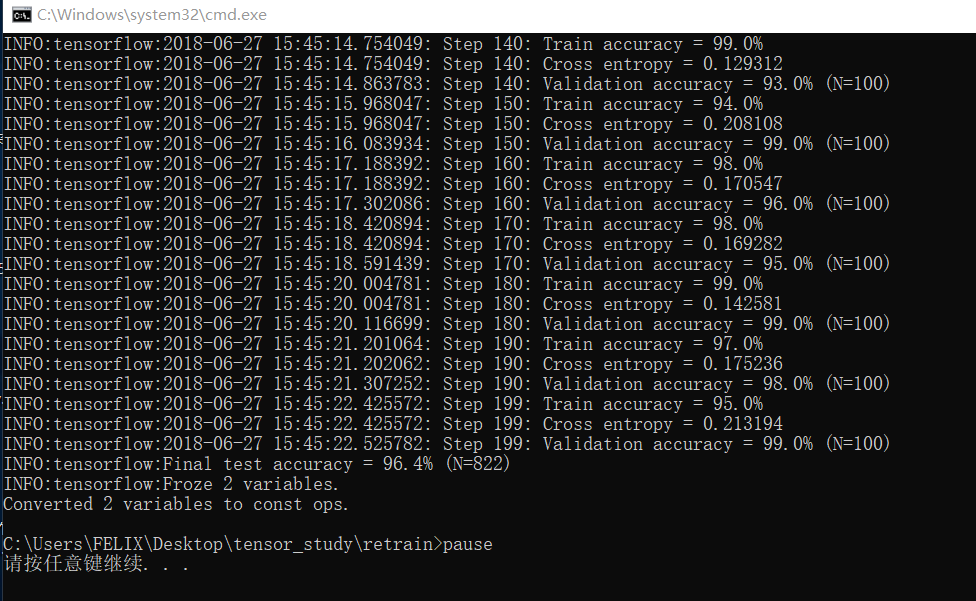
然后在当前文件夹下产生了一个模型文件和一个标签文件:
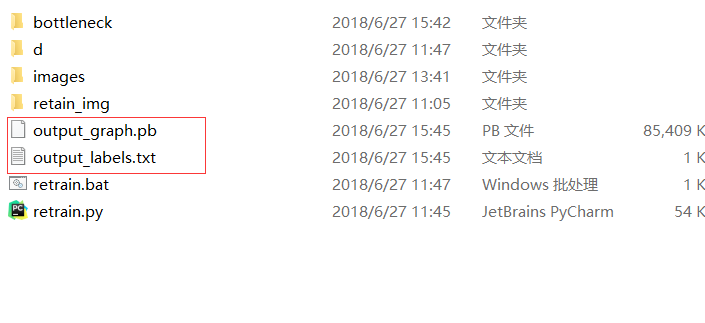
(六)检测模型的效果:
import tensorflow as tf
import os
import numpy as np
import re
from PIL import Image
import matplotlib.pyplot as plt lines = tf.gfile.GFile('retrain/output_labels.txt').readlines() # 读取标签
uid_to_human = {}
#一行一行读取数据
for uid,line in enumerate(lines) :
#去掉换行符
line=line.strip('\n')
uid_to_human[uid] = line def id_to_string(node_id):
if node_id not in uid_to_human:
return ''
return uid_to_human[node_id] #创建一个图来存放google训练好的模型
with tf.gfile.FastGFile('retrain/output_graph.pb', 'rb') as f: # 读取模型
graph_def = tf.GraphDef()
graph_def.ParseFromString(f.read())
tf.import_graph_def(graph_def, name='') with tf.Session() as sess:
softmax_tensor = sess.graph.get_tensor_by_name('final_result:0')
#遍历目录
for root,dirs,files in os.walk('retrain/images/'): # 存放需要测试的图片的路径
for file in files:
#载入图片
image_data = tf.gfile.FastGFile(os.path.join(root,file), 'rb').read()
predictions = sess.run(softmax_tensor,{'DecodeJpeg/contents:0': image_data})#图片格式是jpg格式
predictions = np.squeeze(predictions)#把结果转为1维数据 #打印图片路径及名称
image_path = os.path.join(root,file)
print(image_path)
#显示图片
img=Image.open(image_path)
plt.imshow(img)
plt.axis('off')
plt.show() #排序
top_k = predictions.argsort()[::-1]
print(top_k)
for node_id in top_k:
#获取分类名称
human_string = id_to_string(node_id)
#获取该分类的置信度
score = predictions[node_id]
print('%s (score = %.5f)' % (human_string, score))
print()
测试自己的模型
最后的效果:从效果可以看出识别率还是挺高的。
retrain/images/1.jpg

[2 1 3 4 0]
guitar (score = 0.99594)
automobile (score = 0.00116)
house (score = 0.00107)
rabbit (score = 0.00105)
aircraft (score = 0.00078) retrain/images/2.jpg

[2 1 0 3 4]
guitar (score = 0.97631)
automobile (score = 0.00619)
aircraft (score = 0.00588)
house (score = 0.00582)
rabbit (score = 0.00580) retrain/images/3.jpeg
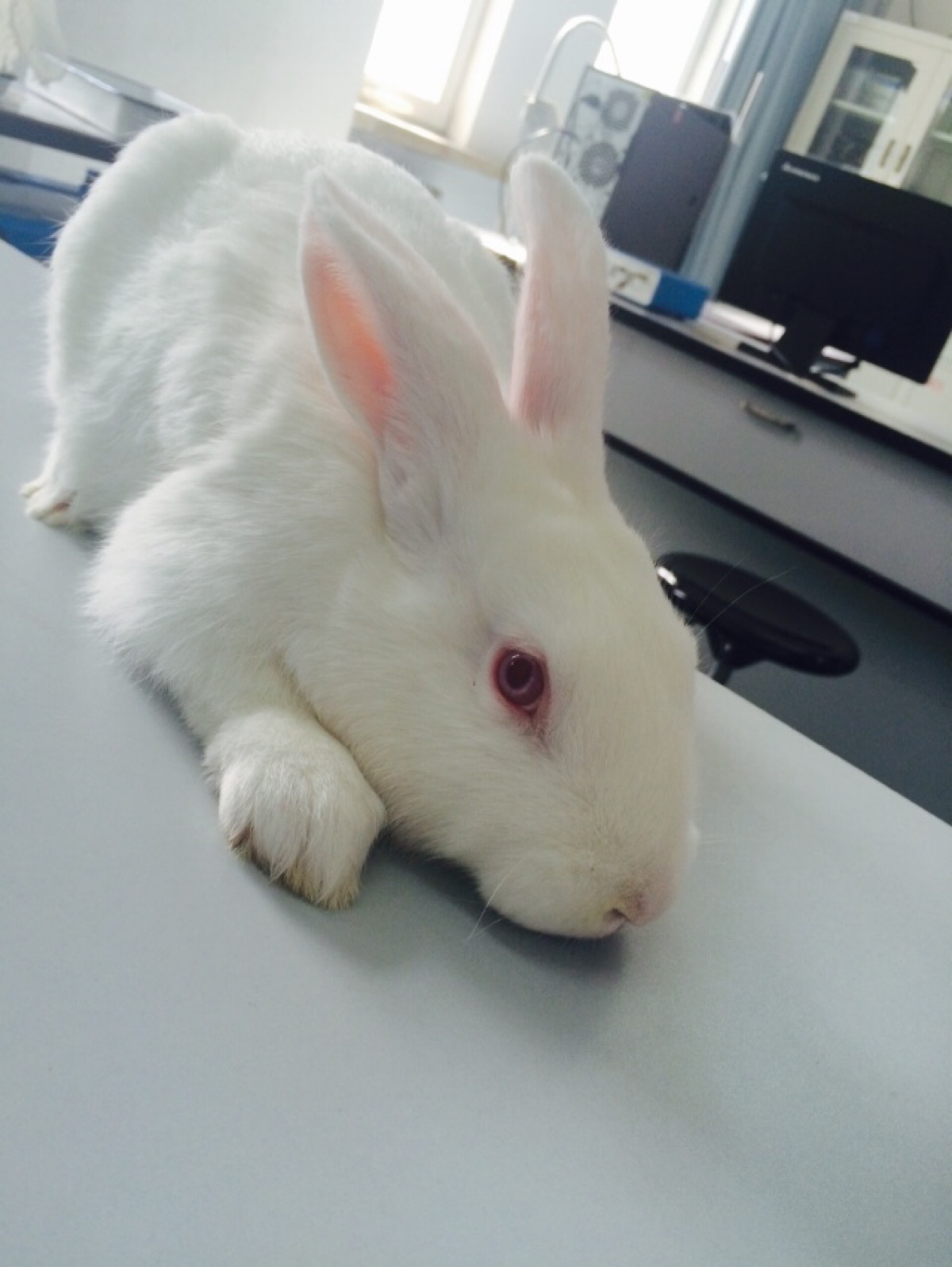
[4 1 3 2 0]
rabbit (score = 0.97687)
automobile (score = 0.00887)
house (score = 0.00531)
guitar (score = 0.00481)
aircraft (score = 0.00413) retrain/images/4.jpg

[4 3 1 2 0]
rabbit (score = 0.97040)
house (score = 0.00882)
automobile (score = 0.00788)
guitar (score = 0.00719)
aircraft (score = 0.00570) retrain/images/5.jpg

[1 2 4 3 0]
automobile (score = 0.95874)
guitar (score = 0.01244)
rabbit (score = 0.01133)
house (score = 0.01015)
aircraft (score = 0.00734) retrain/images/6.jpg
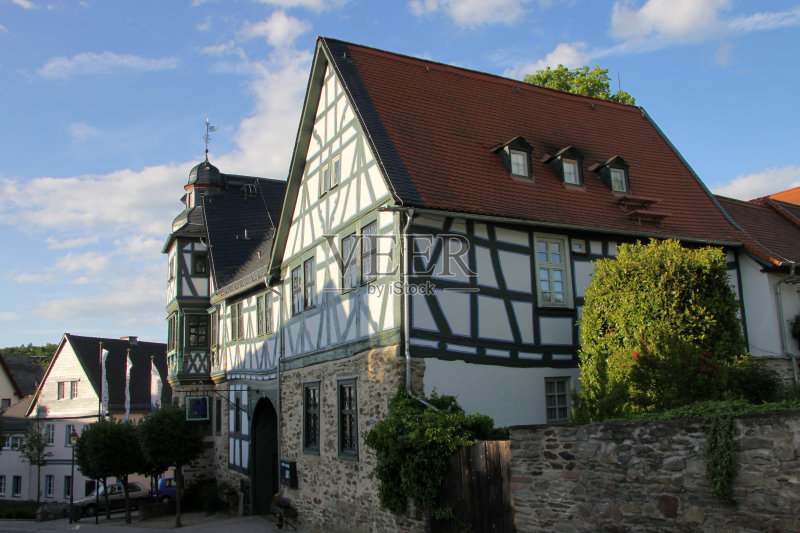
[3 1 4 2 0]
house (score = 0.96955)
automobile (score = 0.01128)
rabbit (score = 0.00844)
guitar (score = 0.00675)
aircraft (score = 0.00397) retrain/images/7.jpg

[1 3 4 2 0]
automobile (score = 0.30635)
house (score = 0.30294)
rabbit (score = 0.22484)
guitar (score = 0.10563)
aircraft (score = 0.06024) retrain/images/8.jpg
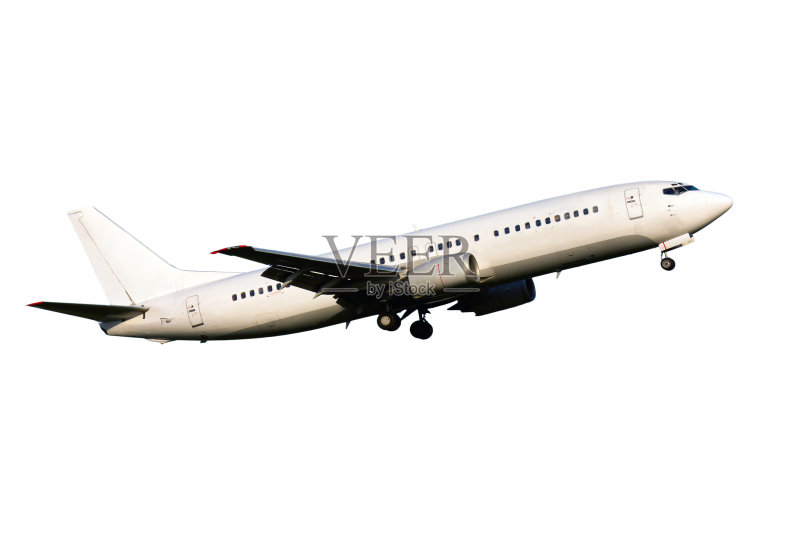
[0 4 1 2 3]
aircraft (score = 0.94436)
rabbit (score = 0.01547)
automobile (score = 0.01387)
guitar (score = 0.01333)
house (score = 0.01296)
TensorFlow(十七):训练自己的图片分类模型的更多相关文章
- PyTorch ImageNet 基于预训练六大常用图片分类模型的实战
微调 Torchvision 模型 在本教程中,我们将深入探讨如何对 torchvision 模型进行微调和特征提取,所有这些模型都已经预先在1000类的Imagenet数据集上训练完成.本教程将深入 ...
- Tensorflow 使用slim框架下的分类模型进行分类
Tensorflow的slim框架可以写出像keras一样简单的代码来实现网络结构(虽然现在keras也已经集成在tf.contrib中了),而且models/slim提供了类似之前说过的object ...
- TensorFlow(十八):从零开始训练图片分类模型
(一):进入GitHub下载模型-->下载地址 因为我们需要slim模块,所以将包中的slim文件夹复制出来使用. (1):在slim中新建images文件夹存放图片集 (2):新建model文 ...
- 一文全解:利用谷歌深度学习框架Tensorflow识别手写数字图片(初学者篇)
笔记整理者:王小草 笔记整理时间2017年2月24日 原文地址 http://blog.csdn.net/sinat_33761963/article/details/56837466?fps=1&a ...
- 源码分析——迁移学习Inception V3网络重训练实现图片分类
1. 前言 近些年来,随着以卷积神经网络(CNN)为代表的深度学习在图像识别领域的突破,越来越多的图像识别算法不断涌现.在去年,我们初步成功尝试了图像识别在测试领域的应用:将网站样式错乱问题.无线领域 ...
- Tensorflow&CNN:验证集预测与模型评价
版权声明:本文为博主原创文章,转载 请注明出处:https://blog.csdn.net/sc2079/article/details/90480140 - 写在前面 本科毕业设计终于告一段落了.特 ...
- 图片杂乱无章、分享麻烦?HMS Core图片分类服务教你快速筛选、分类、整合相册
如今手机摄影越来越方便,随手一拍就能记录美好生活.但照片越多,整理越麻烦,有的时候我们想对照片进行二次加工.分享,需要不停翻找相册.HMS Core机器学习服务(ML Kit)提供了图片分类服务,方便 ...
- 【5】TensorFlow光速入门-图片分类完整代码
本文地址:https://www.cnblogs.com/tujia/p/13862364.html 系列文章: [0]TensorFlow光速入门-序 [1]TensorFlow光速入门-tenso ...
- 基于TensorFlow Object Detection API进行迁移学习训练自己的人脸检测模型(二)
前言 已完成数据预处理工作,具体参照: 基于TensorFlow Object Detection API进行迁移学习训练自己的人脸检测模型(一) 设置配置文件 新建目录face_faster_rcn ...
随机推荐
- jquery封装的方法
<!DOCTYPE html> <html lang="zh"> <head> <meta charset="UTF-8&quo ...
- PHP Math常量
常量名 常量名 常量值 PHP M_E e 2.7182818284590452354 4 M_EULER Euler 常量 0.57721566490153286061 5.2.0 M_LNPI l ...
- 监控SQL:通过SQL Server的DML触发器来监控哪些IP对表的数据进行了修改(2)
原文:监控SQL:通过SQL Server的DML触发器来监控哪些IP对表的数据进行了修改(2) 在有些公司中,由于管理的不规范,或者是便于开发人员直接修改.部署程序,往往任何开发人员,都能登录到生产 ...
- 0.b概述
一.计算机与算法 计算 = 信息处理 计算模型 = 计算机 = 信息处理工具 算法:特定计算模型下,解决特定问题的指令序列 要素:输入 输出 正确性 确定性 可行性 有穷性 好算法:正确 健壮 可读 ...
- iOS - Scenekit3D引擎初探之 - 导入模型+上传服务器+下载并简单设置
SceneKit是ios8之后苹果推出了一个3D模型渲染框架. SceneKit现在可以支持有限的几种模型,截止到我写这篇文章为止似乎只有.dae和.abc后一种模型我没有使用过.这篇文章只针对.da ...
- Questasim10.6c下载安装教程
questasim作为modelsim的高级版,用着速度还是比modelsim爽很多,基本上所有操作指令都是和modelsim兼容的. 不同版本的vivado兼容的modelsim版本是不一样的,如果 ...
- iOS开发常见的宏定义(实用)
iOS开发过程中使用一些常用的宏可以提高开发效率,提高代码的重用性:将这些宏放到一个头文件里然后再放到工程中的-Prefix.pch文件中(或者直接放到-Prefix.pch中)直接可以使用,灰常方便 ...
- 关于#error
很简单的一个东西,但是感觉使用价值没有太大.实现了以下,结果如下: 执行到#error语句的时候直接停止编译,在下面输出设定好的错误信息. 来自为知笔记(Wiz)
- CentOS7安装CDH 第八章:CDH中对服务和机器的添加与删除操作
相关文章链接 CentOS7安装CDH 第一章:CentOS7系统安装 CentOS7安装CDH 第二章:CentOS7各个软件安装和启动 CentOS7安装CDH 第三章:CDH中的问题和解决方法 ...
- Django的结构
一.Django的结构 二.静态文件的配置 STATIC_URL = '/static/' # HTML中使用的静态文件夹前缀 STATICFILES_DIRS = [ os.path.join(BA ...
